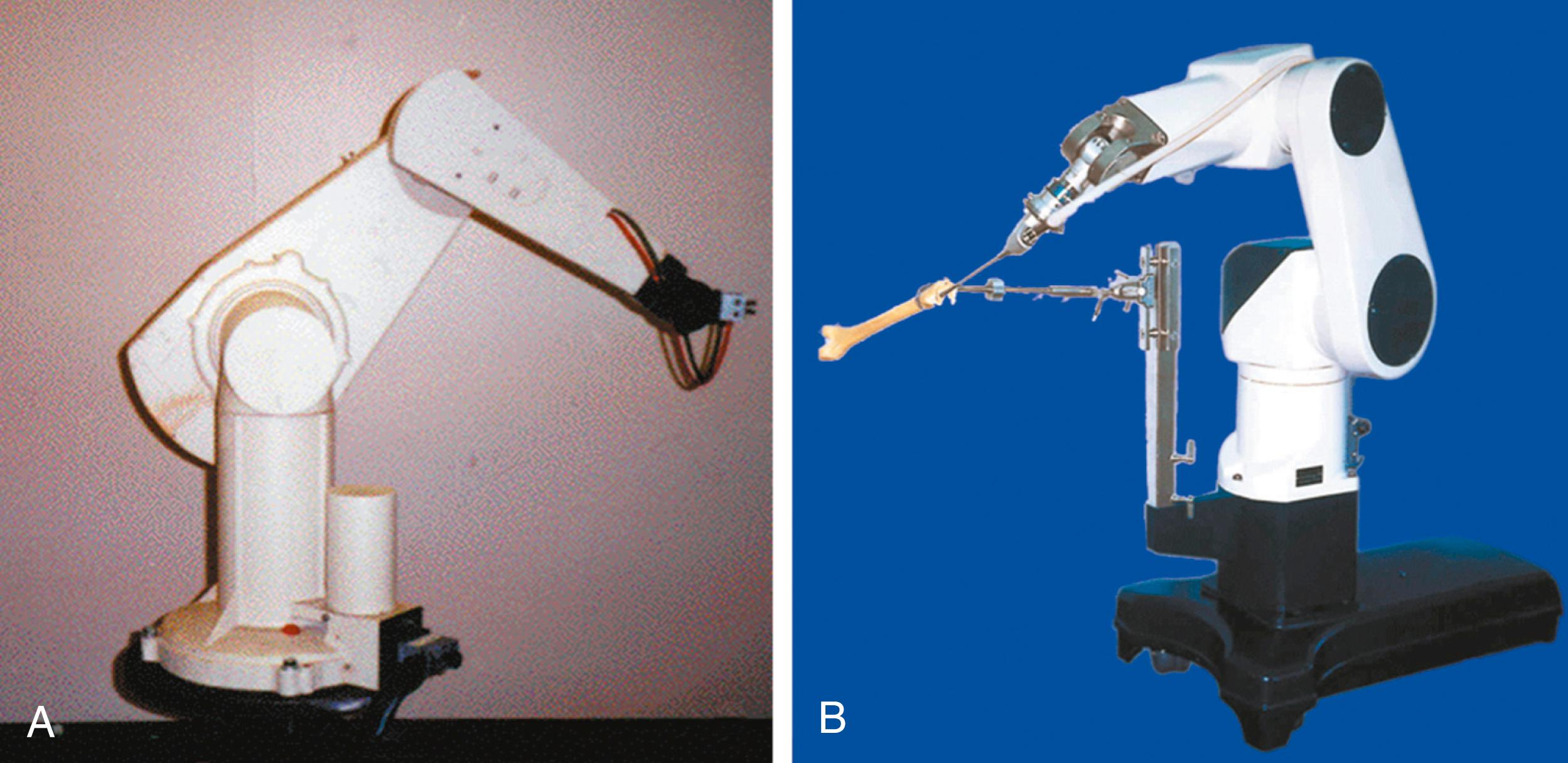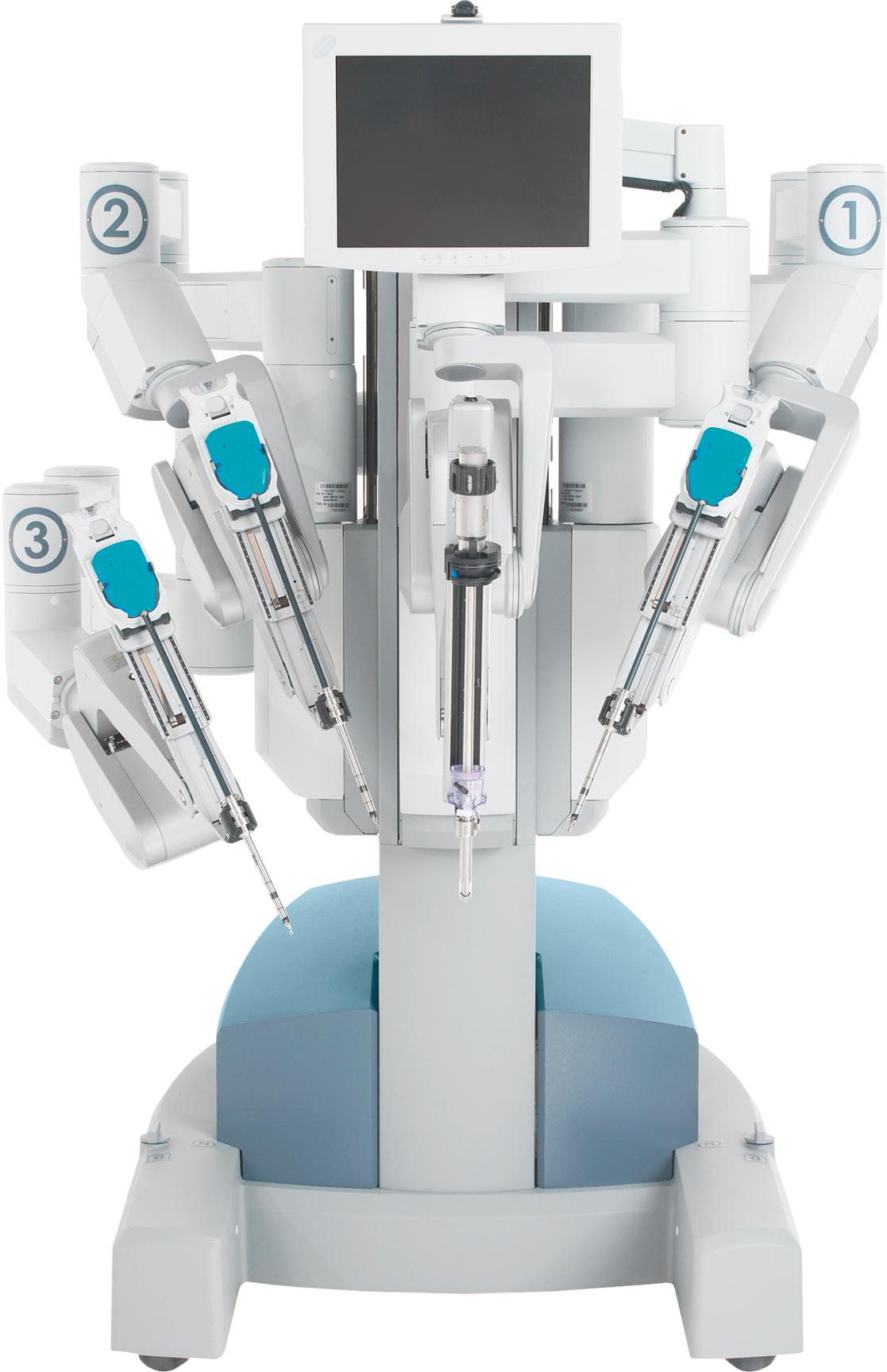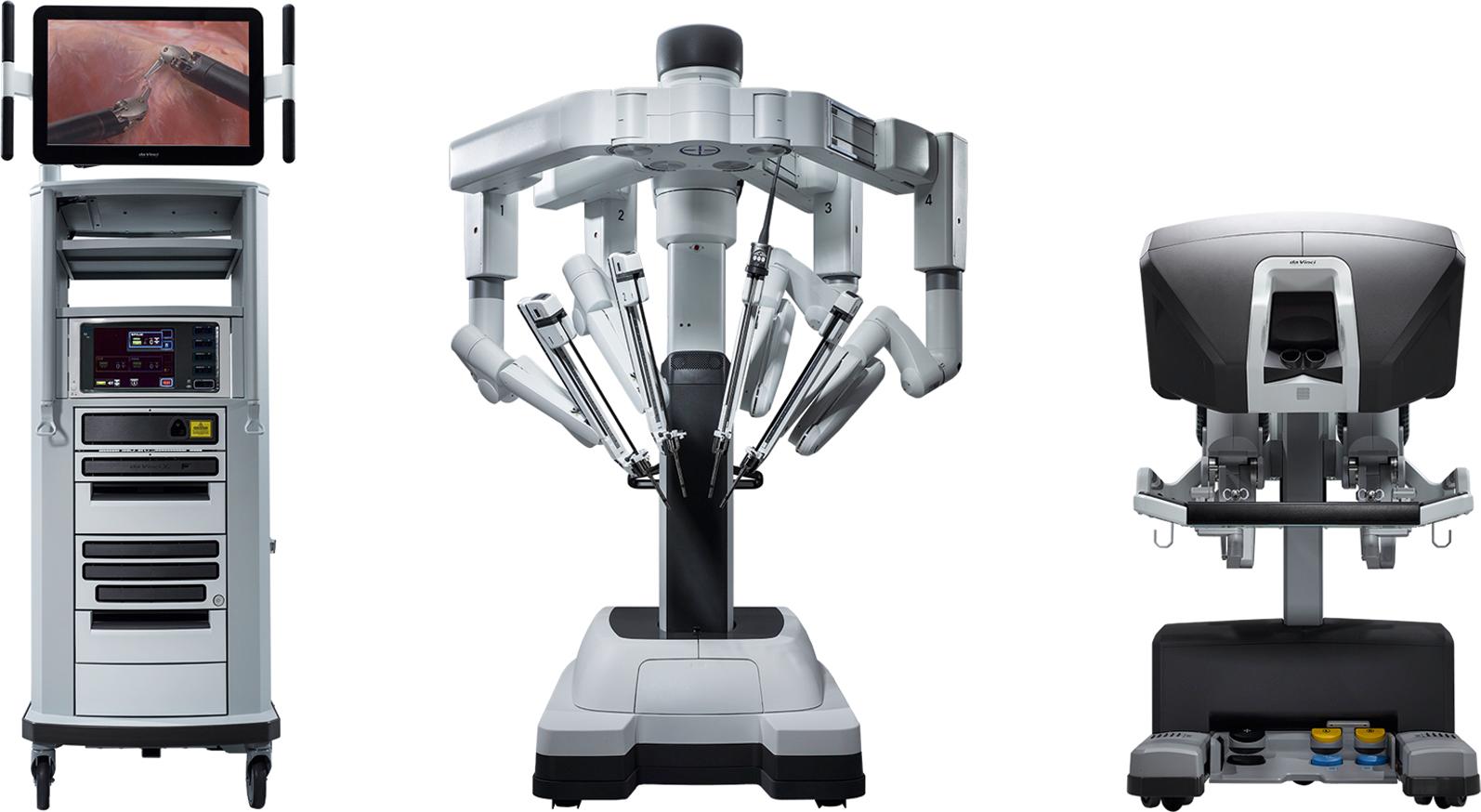Physical Address
304 North Cardinal St.
Dorchester Center, MA 02124
![]() Access the accompanying videos for this chapter online. Available on ExpertConsult.com .
Access the accompanying videos for this chapter online. Available on ExpertConsult.com .
Robotic surgery is a well-established technology in all surgical specialties. An enormous variety of cases have been accomplished with robotic technology in general surgery, urology, gynecology, and otolaryngology. Pediatric surgery has lagged in the adoption of this technology, largely due to the high cost of the equipment and the limitations the larger instrumentation poses for our small patients. Despite these challenges, the variety and number of cases of pediatric procedures continue to grow. This chapter will review the history of robotic surgery, discuss the advantages and limitations of the current technology, and outline some tips, tricks, and principles that may help pediatric surgeons adapt the current technology for children. Finally, a few selected operations will be described.
Most surgeons now perform a wide variety of basic or moderately complex minimally invasive procedures (MISs). However, more advanced procedures can still be quite difficult. Limitations in current laparoscopic equipment include a reduction in haptic feedback (force and tactile), hand–eye coordination, and dexterity. Depth perception can be compromised as well. Most laparoscopic operations are performed using a single camera lens creating a two-dimensional surgical image of a three-dimensional surgical field. Additionally, as the laparoscopic instruments pivot about the cannula site, the motion of the surgeon’s hand translates to the opposite movement in the patient. This is known as the fulcrum effect. Another limitation is the restricted degrees of motion with standard laparoscopic instruments. Most current laparoscopic instruments have four degrees of motion, whereas the human wrist and hand have seven degrees of movement. Finally, physiologic tremors in the surgeon’s hand are transmitted through the length of rigid instruments. Robotic technology addresses most of these limitations and might improve overall results.
The term robot was first introduced in the script for the play “R.U.R.: Rossum’s Universal Robots” by Karel Capek in 1921. In its original Czech translation, robota means “drudgery” or “servitude.” In the play, the robots were manufactured servants that closely resembled humans. The term has since been adopted for many forms of automated characters in movies, plays, and television. In practice, the term robot has been used to describe a multitude of automated devices that are present in just about every industry. It was only a matter of time before this technology would enter the medical field.
One of the first robotic systems used in medicine was the Puma 560, a device first used in 1985 by Kwoh to perform neurosurgical biopsies ( Fig. 27-1A ). Three years later, Davies used the Puma 560 to perform a transurethral resection of the prostate. In 1988, PROBOT was introduced to perform prostatic procedures in England. In 1992, Integrated Surgical Systems unveiled the ROBODOC, a device used to mill out precise fittings in the femur for hip replacement surgery ( Fig. 27-1B ). This was a significant advancement, and the ROBODOC became the first surgical robot to gain U.S. Food and Drug Administration (FDA) approval, bringing technology and robotics into mainstream surgery.

In the 1990s, a group of researchers at the Department of Defense (DOD) teamed with scientists at Stanford’s Research Institute (SRI). They were interested in finding a way to decrease wartime mortality by treating battlefield casualties from a remote operative station. This concept of “telepresence” would allow a surgeon to be in one location while potentially treating multiple casualties in a variety of sites. SRI developed the prototype for this concept, the Green Telepresence Surgery System. Although initially designed for open procedures, several of the engineers had the vision of bringing this technology into the MIS realm. Intuitive Surgical Inc. (Sunnyvale, CA) was founded to test this concept. The DOD sold the licensed technology and intellectual property to this group, and this system was extensively redesigned into the Da Vinci Surgical Robot.
While Intuitive Surgical was developing the Da Vinci, another company called Computer Motion (CM) emerged in the field of robotics. They began with the creation of a camera system that responded to a surgeon’s voice command. This became known as AESOP (Automated Endoscopic System for Optimal Positioning) ( Fig. 27-2 ). Eventually, CM developed the Zeus system, and the competition between the two companies quickly accelerated. CM had a landmark event in robotics history in 2001. While seated at a console in New York, a surgeon performed the first transcontinental robotics procedure using the Zeus system by removing the gallbladder from a patient in Strasbourg, France. Meanwhile, the Da Vinci was being used to help pioneer the minimally invasive prostatectomy.

Both systems enjoyed early success, but progress was hindered by legal battles between the two companies. However, Intuitive was clearly the dominant company with much better capital and better stability. Eventually, Intuitive acquired CM in 2003. The merger left the medical field with a sole provider of surgical robotics. With Intuitive now owning both platforms, focus quickly shifted to the Da Vinci and the Zeus system was abandoned. For nearly 20 years, the Da Vinci has been the sole robot in nearly all surgical specialties.
The first Da Vinci System was unveiled in 1999 and first put to clinical use in 2000. There was a lot of initial excitement with the emergence of this technology, and robotic cases were done in a wide variety of fields. Cardiac surgery was an initial target for the first Da Vinci system, but it soon became apparent that urology, gynecology, and general surgery had many more applications. However, there were several limitations with the first robot. Besides the poorly adaptable analog technology for any add-on features, the first robot had a time-consuming docking mechanism, which required assembly for each case with a wrench. However, one interesting design addition for the initial standard Da Vinci was the ability to use a special 5-mm scope. In pediatrics, this smaller scope was a nice alternative to the 12-mm three-dimensional telescope and allowed for a large number of very small patients to have robotic operations.
In 2005, the Da Vinci S was designed as the first digital robotic surgical system ( Fig. 27-3 ). The new robot had several significant improvements over the first-generation device, including better range of motion and a much-improved docking system. The chassis was now designed for a fourth arm, so its functionality was tremendously better and use of the fourth arm became more popular. The robot cart was motorized for the first time, which helped operating room (OR) staff move this behemoth equipment much easier. The S also accommodated the 5-mm two-dimensional camera.

Unfortunately, sales of the 5-mm two-dimensional scope never improved, and Intuitive abandoned manufacturing this scope in 2009. Moreover, the 5-mm scope was not compatible with the next-generation Da Vinci robot (the Si model), which was released in 2010. On the positive side, an 8-mm three-dimensional scope had been developed. The 8-mm three-dimensional scope first appeared in 2007 and eventually became a popular product with the S and Si models. The current fourth-generation Xi (2015) uses an 8-mm camera that has chip-on-a-stick technology ( Fig. 27-4 ).

Another issue important to pediatric surgeons is the diameter of the minimally invasive instruments. Smaller is better. The initial 8-mm diameter, which began in 1999, seemed too big for many pediatric applications. In 2004, 5-mm instrumentation was first released. The snake-like design was significantly different from the pitch-roll-yaw motion of the 8-mm instruments. While it has the advantage of a smaller diameter, its disadvantage is a longer articulating length. This design had been initially created in competition with the 5-mm CM system. Interestingly, in over 15 years since the first release, no modifications, no improvements, and no additional instrument selections have been made. Moreover, the Xi system is not compatible with the 5-mm line. The end-of-life letter for the Si system was released in early 2019, which indicates the Si system will no longer be supported in the very near future. Unfortunately, when the Si system support stops, so will the 5-mm instrument line.
Despite the loss of the 5-mm line, the fourth-generation Da Vinci Xi has many important improvements. The most significant is the ability to move the camera from port to port. Additional advantages include the stick-on-a-chip optical technology, creating a much improved three-dimensional optical system. Longer instruments are helpful for bariatric cases, and the overhead boom mechanism makes docking and room positioning much more efficient. The size of the arms has been reduced, and the range of motion of each arm has been increased. Intuitive now offers a modified fourth version of the Xi, the Da Vinci X. This version was created by stripping down an old Si to the chassis and adding the robotic arms of the Xi. The benefit is a significantly reduced cost compared to the Xi, but without the overhead rotating boom. Meanwhile, the single-port Da Vinci (SP) has also been released, which has some interesting but limited applications. A summary of all the Da Vinci systems is shown in Table 27-1 .
| Year | Model | Cost | Use | Highlights and New Features | Limitations |
|---|---|---|---|---|---|
| 1999 | Standard | $1.2 M | Multiport | First robotic system Designed as a three-arm system, although a fourth arm could be added 5-mm instruments introduced in 2004 Three-dimensional 12-mm and two-dimensional 5-mm scope |
Analog system Cumbersome docking Not well designed for the added fourth arm |
| 2005 | S | $1.5 M | Multiport | First digital system Motorized cart Improved docking system Three-dimensional 8-mm scope introduced |
Bedside monitor placed on the robot cart was less effective Cables between robot, surgeon cart, and vision cart cumbersome and poorly designed |
| 2010 | Si | $1.7 M | Multiport | Further improved docking mechanism Improved easy-to-plug cable connections Improved harmonic scalpel |
Not compatible with 5-mm two-dimensional scope No improvements or advances in 5-mm instrument line |
| 2014 | Xi | $1.85 M | Multiport | Ability to move the camera to any port Longer instruments Small-profile robotic arms Dynamic rotating boom with optimized docking Retirement of the 12-mm three-dimensional scope, all scopes are now 8 mm three-dimensional |
Not compatible with 5-mm instruments |
| 2017 | X | $1.3 M | Multiport | Less expensive option to the Xi Includes most of the benefits of the Xi except no rotating boom |
Refurbished Si Boom does not rotate |
| 2018 | SP | $2.0 M | Single port | First single-port robotic system approved for general surgery Has multiple instrument arms with three-dimensional imaging |
Currently only FDA approved for a few procedures Longer articulating length, limiting applications for pediatric surgery |
When using the Da Vinci, the surgeon sits at the ergonomically designed surgeon’s console, which can be several feet away from the operating table. The console is attached to the surgical cart via electric cables, which transmit information between the master surgeon’s console and the surgical cart (“robot”) with virtually no delay. At the console, the surgeon receives video input from the operative field by placing his or her head into the high-resolution stereoscopic viewer. The viewer projects images viewed by the dual-channel endoscope. The surgeon is then provided with a 10-fold, magnified, three-dimensional image of the operative field. The stereoscopic viewer is positioned at the console to project the three-dimensional image of the surgical field directly atop the surgeon’s hands. This provides a more natural system of hand–eye coordination and movement, thereby giving the surgeon a sensation of immersion within the operating field. Finally, the sides of the viewer contain infrared sensors that detect the presence of the surgeon’s head, allowing manipulation of the robotic arms only when the surgeon’s head is within the viewer.
In addition to receiving video input, the surgeon controls the three robotic arms of the surgical cart (the “robot”) from the console. This is accomplished using dual master controls patterned after Castro-style needle drivers ( Fig. 27-5A ). By manipulating these master controls, the surgeon controls the laparoscopic instruments, held by the two robotic operating arms, and the endoscope, held by another robotic arm. The surgeon’s movements of the master grips are directly translated into corresponding movements of the tips of the articulating instruments. Similarly, wrist movements of the surgeon’s hands are directly translated into wrist movement of the instruments. One criticism of the current Da Vinci robot is the lack of haptic feedback. The surgeon receives gross force feedback via the master controls when manipulating more rigid structures, but fine haptic sensation is not currently available.

Once only available as an option, a fourth arm is now standard on all X and Xi systems, and gives the surgeon a second left hand or a second right hand. The surgeon can switch between the two left hands or two right hands by using a foot pedal. Alternatively, two consoles can be used as a pilot and copilot; the second surgeon serves as an assistant with control of one or more instruments. Control of the instruments can be passed from one surgeon to the other. This becomes invaluable in new surgeon or resident training as both surgeons see the same field, and control can be easily passed from one to the other.
The master surgeon’s console also allows the surgeon to manipulate the camera location, depth, and focus. To manipulate the endoscope, the surgeon depresses and holds down the camera control pedal. When this pedal is depressed, the master grips are disengaged from the instruments and instead control the movement of the endoscope. Similarly, the surgeon is able to rotate the scope as well as change the depth of the scope by simply manipulating the master grips. Focus is accomplished by turning the finger mechanisms for one hand or the other. A clutch pedal allows the surgeon to disengage the master grips from the surgical cart, allowing repositioning of the master grips into a more comfortable configuration without moving the instruments or the endoscope. A finger clutch is available on each master for the left and right hands if the surgeon wishes to clutch and reposition only one of the masters. A series of additional pedals are engaged for a variety of useful common surgical accessories, such as monopolar electrocautery, bipolar electrocautery, tissue staplers, thermal tissue sealers, and suctioning.
Finally, a vision overlay system is now standard on the Xi model. This technology utilizes indocyanine green (ICG) to help recognize anatomy and tissue perfusion. ICG is a fluorescent molecule that can be seen via infrared endoscopic equipment now commonly available (Firefly, Intuitive Surgical, Sunnyvale, CA), including on the Da Vinci system. ICG is given intravenously and can help identify areas of tissue ischemia and the extent of certain tumors, and can be useful in identifying the correct anatomy such as the cystic and common bile ducts during a minimally invasive cholecystectomy.
The next component of the Da Vinci system is the vision cart, a movable tower that houses the light source, camera equipment, and monitor (see Fig. 27-4 ). It can also house additional accessory equipment such as the insufflator, cautery, and a variety of other accessory equipment such as the power system for the robotic stapler and tissue sealer. The monitor has a touch screen, which can be draped and allows the bedside assistant to telestrate on the monitor, which can be visualized by the surgeon.
Become a Clinical Tree membership for Full access and enjoy Unlimited articles
If you are a member. Log in here